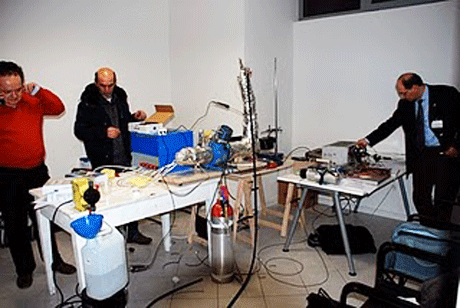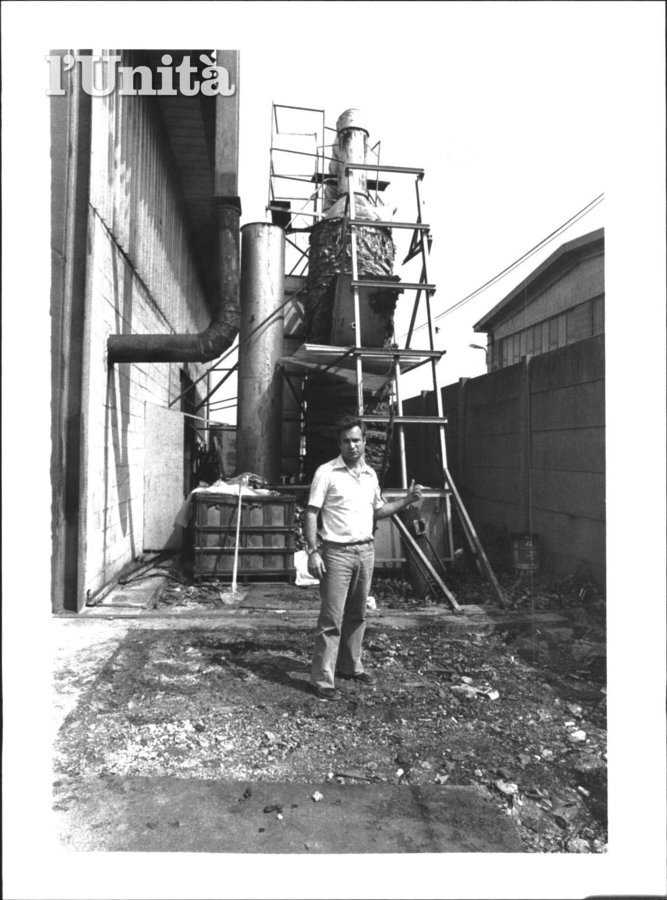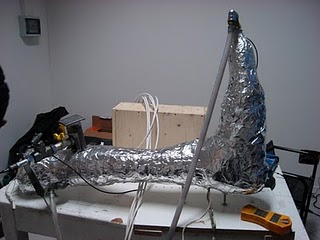Italian Engineer announces commercial 'Cold Fusion' reactor
Italian engineer Andrea Rossi and Professor Sergio Focardi of the University of Bologna announced in January 2011 that they have mastered an energy catalyzing technology that produces heat from a reaction between hydrogen, nickel and some other - so far secret - ingredients. Their press conference on 14 January 2011 was preceded by an invitation-only demonstration of the reactor attended by press and scientists.

They are careful not to describe their reactor as a "Cold Fusion" generator - probably because the term has become so controversial it is almost impossible to have a serious discussion about its practical application. Sterling Allan has been reporting on this development in PESWiki:
Directory:Andrea A. Rossi Cold Fusion Generator
Rossi has been into alternative energy for many years. It was in the 1970s and 1980s that Rossi was busy building garbage disposal facilities that burned household garbage and utilized the recovered heat. During that period, he found out how to not only recover heat from burning garbage but also to turn garbage into fuel. His company, Petroldragon, had a valid garbage-to-fuel technology that could turn household waste into combustible oil, coal and gas. Production had started and reached some 20 tons of fuel oil a day in 1989, when corrupt bureaucrats started to attack.
The first step was to tax his process just as if he was producing alcohol, making the resulting fuel ridiculously expensive. When he opposed the unjust tax, the next step was a challenge that proved more difficult: the bureaucrats asserted that the garbage stocked and ready to be transformed in his production facilities wasn't raw material for his process but was an illegal and fraudulent attempt to hide and "treat toxic garbage" for which he had no license.

Andrea Rossi in front of an early (1970s) prototype of his garbage-to-fuel reactor
Rossi was imprisoned on trumped up eco-charges for trying to produce an ecologically sustainable fuel that did not come from petroleum deposits, and after one of his companies was forced into bankruptcy, he was again imprisoned for not paying his creditors ... great government support for alternative energy technologies, one might say. That whole sad story is well documented on Rossi's website:
The beginning, the media boom around Petroldragon, plans for the future
But let's get back to "cold fusion" and its first real commercial implementation.
As we have seen, Rossi is a serious industrialist and not one to give up easily. His announcement of a new energy technology, based on a catalytic process involving hydrogen, nickel and a few other elements has made waves in the blogosphere, but strangely, the mainstream media have stayed away from the story. It is almost as if they were afraid to repeat the disaster of the Fleischmann and Pons revelations about their "cold fusion" discovery, where glowing press reports had brought every skeptic on the face of the earth out of lethargy, "proving" that such low energy nuclear processes were just not possible - as if forbidden by the laws of physics we know.
No matter that the Pons and Fleischmann process has since been replicated hundreds of times with several variations, and been described in what must be thousands of published articles (see collection of papers on lenr-canr.org), that numerous experimenters and theoreticians have been working on lifting low temperature fusion's secrets and explaining the transformation of certain elements observed during the experiments, no matter that we now have an actually workable and controllable implementation of the principle ... there is a great silence of the media that are supposed to inform us.
- - -
One (reactor) size fits all
The fusion ... pardon ... catalytic reactor of Rossi and Focardi is a relatively simple implementation of the cold fusion concept. Hydrogen gas is introduced in a chamber that contains a powder of nickel and a few other, yet unspecified, elements. The gas is pressurized and heated by means of an electrical resistance. After a short warm-up time, the chamber starts self-heating and giving off better than ten times more the thermal energy over what is put in by the electric heating element. The steam output is the equivalent of 10 - 12 KWh of thermal energy, in contrast to an electrical input of 600 - 700 W/h. There is very little consumption of the hydrogen gas, indicating that it is not a hydrogen combustion process but a low energy nuclear reaction that is catalyzed in the apparatus.

So we are talking about a fuelless technology, or at least a very low fuel consumption, and a closed-loop electric generation process that can sustain itself for years in an autonomous fashion. Costs are rather low. According to an interview with Rossi, published on an Italian blog (Energy Catalyzer: facciamo un po' di chiarezza) the reactor construction cost is around 2000 $ per kW, and the cost of electricity production is estimated to be around 1 cent per KWh.
The reactor is a standard size and configuration. In order to scale up production, Rossi is avoiding any change in size for now. The available size reactor is secure. Its function is understood and well controlled, so the first step will be to manufacture more of those reactors and link them into larger generation facilities. Reactors can be linked in series, to achieve higher absolute steam temperatures, and in parallel, to achieve greater volume of steam production. Converting the steam into electricity has the usual limitations, and Rossi says that 10 KWh thermal energy can be converted into 3 to 3.5 KWh of electric output.
The first larger facility is planned to have a thermal capacity of one MWh, combining a hundred units, and will have an electrical output of some 300 to 350 KWh. Estimated time of completion is October 2011.
In an industrial environment, the reactor can be run without problems, and it is expected that such industrial-sized reactor units will be mounted in shipping containers for easy transportability. It will be more difficult to obtain permits for individual household-type units, because of the requirement for complete automatic and safe operation under all circumstances. For now, trained personnel that cares for maintenance is still necessary, so household units seem to be about a decade in the future yet.
The most complete coverage of the announcement and various commentary is available at the PESWiki site, which also has links to other reports ...
Directory:Andrea A. Rossi Cold Fusion Generator
An example of a more mainstream (but rather skeptic) coverage is this phys.org article
Italian scientists claim to have demonstrated cold fusion
In German, published in NET Journal:
Unerschöpfliche Energie aus einer Nickel-Wasserstoff-Reaktion
Here is a recent interview by Italian blogger-journalist Daniele Passerini
Energy Catalyzer: facciamo un po' di chiarezza
and an English rendition of the post on the Pure Energy Systems site of Sterling Allan
Interview with Rossi (cold fusion) to get clarity on his catalyzer technology
- - -
See also:
Cold Fusion: Edmund Storms on the Rossi device... "There will be a stampede."
"The Swedish newspapers, the Italian newspapers, the Greek newspapers, they showed an interest. The American newspapers showed none at all. It's been on a number of blogs and talked about in a number of chat rooms, but no, it hasn't reached a level of any serious importance to the American press."
"Of course, he's taking orders, and I'm sure there'll be people from all over the world, where regulations are not quite so severe and minds are more open than they are here, and they'll buy units, and put them in their factories, and suddenly the cost of energy to those companies will go down significantly, and all of a sudden people will panic, and then there'll be a stampede to buy these things."
Cold Fusion Steams Ahead at World's Oldest University
Progress accelerates as a year long study of Andrea Rossi's Nickel-Hydrogen Cold Fusion technology (energy catalyzer) at the University of Bologna is announced. The birthplace of higher education has become the developmental womb for a game changing technology!
Check this site for latest news on Rossi's Energy Catalyzer or e-Cat
Related:
Zirconium Flavored Cold Fusion from Poland
Ukranian inventor, Profesor Bolotov, has developed a cold fusion reactor based on the transmutation of Zirconium to other elements. He claims a system could have an input of 5 kW and an output of 200 kW. This is from a system that only costs 10,000 euro to build. It was demonstrated for academic review on March 25.
NASA Chief Scientist: Rossi eCatalyzer "Could Change Geo-Politics / Economics"
The most interesting, and promising, at this point, in the farther term, but maybe not so far, is low-energy nuclear reactions. This has come out of years of people producing energy but not knowing what it is -- and we think we have a theory on it. It's producing beta decay and heat without radiation. The research on this is very promising and it alone, if it comes to pass, would literally solve both [the] climate and energy [problems.]
Comments
February 16, 2011 6:41 PM | Posted by: Mark
>The fusion ... pardon ... catalytic reactor of Rossi and Focardi is a relatively simple implementation of the cold fusion concept.
Sorry, but the Facardi & Rossi reactor seems to make use of a (bidirectional) chemical catalytic carrier reaction to support the CF. This means it is relatively complex, but the only reliable control methodolgy currently known.
February 16, 2011 6:53 PM | Posted by: Mark
> Production had started and reached some 20 tons of fuel oil a day in 1989, when corrupt bureaucrats started to attack.
Government history in the alternative energy field is so bad that it is no longer worthy of trust. In general we will benefit from controlling government tendencies rather than taking advantage of them. IMHO. The problem might be that Rossi could be repeating history by not bringing scientific understanding along and isolating himself and his project. We shall see.
February 18, 2011 4:05 PM | Posted by: bumgahdna
LOL it's always about a decade away, isn't it?
February 21, 2011 6:56 AM | Posted by: Paramahamsa Tewari
Comments given by me on the earlier Karpen's pile was pinpointed due to an exchange of innermost orbit electron between the Platinum and Gold atoms. On similar lines, i belive that the missing name of the element in Facardi and Rossi reactor should be copper.
Paramahamsa Tewari
February 28, 2011 6:58 PM | Posted by: Rockyspoon
I'm betting that as soon as the commercial units have been operated for a while, commercial units for household or small commercial scale (hospitals, schools, municipal buildsings, etc.) aren't that far away.
April 1, 2011 3:18 PM | Posted by: cheneyssshotgun
Actually, bumgahdna, I heard an interview with Rossi a few weeks ago, and his plan was to have the first 1MW plant up by 2012 for testing in the industrial enviornment, and immediately following that several plants are planned across the US for introduction into the market.
In the coast to coast interview he didn't mention setting up household sized systems.
April 13, 2011 7:48 PM | Posted by: Tim
it would seem that the cost of $2000 per Kw is not so low. maybe that was for the first one. But the parts list doesn't come to more than a few hundred dollars in one off prices. The quoted price would put it on par with new solar technology.